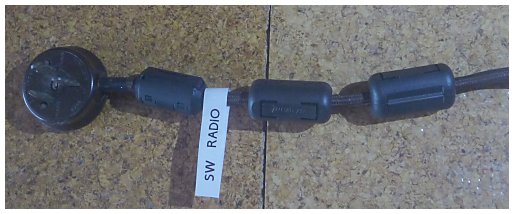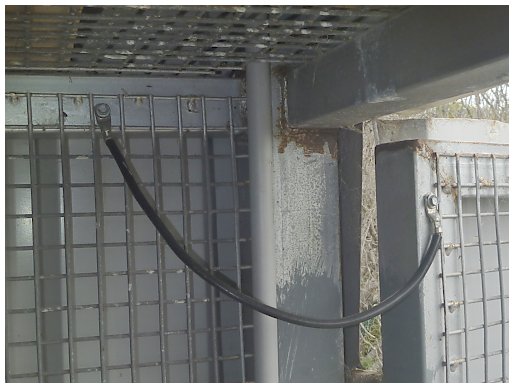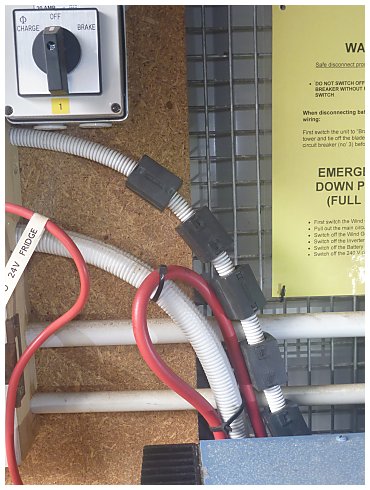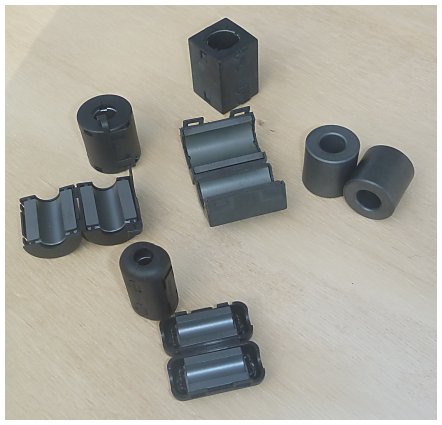|
A guide to self reliant living |
||||
|
6. Kerosene heaters and cookers 12.
Electrical; generators Miles Stair's SURVIVAL Miles Stair's SURVIVAL
|
Radio Reception Noise and Interference by Rob Gregor in the Outback of Australia Practical examples of reducing EMI/RFI in Stand Alone Power Systems RFI/EMI: Despite some argument on technical differences, the terms RFI (Radio Frequency Interference) and EMI (Electro-Magnetic Interference) are commonly used to describe the same phenomena, which is that of disruptive electrical noise generated mostly by nearby items of electrical equipment and infrequently by local thunderstorm activity. This noise travels by radio waves in free space and along the hard wiring that connects various items of electrical equipment in your residence. It varies in its intensity from a nuisance level of background noise, as is commonly heard on a radio receiver when attempting to locate a distant station, right through to severe which is disruptive and blanks out all but the strongest radio signals. In some instances, it can seriously disrupt the operation of electrical equipment such as Bluetooth and Wi-Fi devices. In the case of its deliberate use as a military weapon, a massive EMI pulse can cause permanent damage to many items of unprotected electrical equipment, including mains power networks, and apparently it can erase the memory storage in computers over a wide area. The reason for writing this article: In our situation, my wife and I live in an isolated coastal area in South Australia and we have had to develop a good degree of self sufficiency i.e. we build and maintain our own access roads, collect our own fuel for heating and use stored rain water for drinking. We generate our power from solar panels and wind generators and we need to have back- up systems for most things. Keeping abreast of local and international news is important to us and we typically use a Satellite TV/Radio system. However, that is occasionally subject to periods of very poor reception from thunderstorm activity, therefore we also use back up radio receivers for listening to music and news broadcasts on the MW (Medium Wave) SW (Short Wave) and FM (low VHF) Bands. Two of these radios are vintage valve/tube radio receivers, which have an impressive performance when fitted with a permanent long wire/random wire antenna and we also have a good quality portable transistor radio which has a built in ferrite rod antenna. Because all but a few of the radio stations are distant from us by at least 400 Km (and on the SW Band) are even located in other countries, the signals vary from weak to medium strength only and they were being severely disrupted by the RFI noise that was emitted from our own power generation and distribution system. When I began the process of exploring options to reduce the level of RFI, I did not manage to easily locate straight forward guides on "how to reduce RFI/EMI in the domestic situation" and I had to rely mostly on articles of a technical nature which tended to focus on such items as "process controllers" or VHF/UHF Radio Communications and within a commercial environment. This has prompted me to write a simpler guide that sets out the process I have used to successfully minimize RFI from a "stand alone" power system and which also provides some practical tips that may assist others who find themselves in a similar situation. Typical sources of RFI: Inverters and transformers, solar regulators, electrical motors (such as in water pumps, freezers, refrigerators, washing machines) fluorescent lights (especially compact FL’s) and mains power lines to your residence are among the most common sources of strong RFI. Also, in our situation, the RFI intensity emitted by our sophisticated solar regulator varied depending on how busy the regulator was at any time of the day as did from other appliances that are "demand activated". Less common sources of strong RFI are intermittent shorts or poor connections in house wiring, wall sockets or old electrical equipment and among the worst offenders for RFI are some makes of plasma TV’s and commercial welders such as Arc, TIG or MIG. These are often the most difficult to track down if they are located in your neighbourhood but not under your direct control. Wind generators, the "power packs" for down lights, some flood lights and even for powering PC’s or charging batteries in various devices that we all use on a regular basis, are common causes of medium to strong RFI. Again, in our own situation, we found many other everyday electrical appliances that emitted low levels of RFI but as we could control their time of use, we did not consider these to be other than nuisance value. N.B. I believe that it will be helpful to interested readers if they appreciate that the amount of RFI emitted in their locality will vary in its intensity and in its frequency spread, depending on who else is operating equipment nearby and by whichever manufacturer has made the equipment. It can even vary between the various models made by the same manufacturer, as I have found when testing LED Bulbs. With this being the case, then the nature of the problem and the cures may differ from situation to situation but the steps which I have outlined will still be useful in the majority of domestic situations. Tracking the source: As I do not have sophisticated test equipment, I used a portable radio that has an internal and directional ferrite rod antenna plus my ears to track the sources of RFI. This involved walking from point to point inside and around our house and power shed and scanning across the broadcast frequencies, in order to roughly locate the worst sources of RFI. Then after I had taken measures to obtain some reduction to the level of interference, I then went back over the same routes and rescanned across the various broadcast bands in order to check the remaining locations of RFI. RFI noise reduction options: The most commonly suggested options seem to be as follows: Replace those items which produce RFI with ones that don’t (generally only practical with a few items due to the expense involved) Use a Farraday cage to shield equipment from the sources of RFI Bury the mains power cable** Add ferrite cored RFI/EMI filters to power leads Use earthed metal shielding around power leads (not very practical in our situation) Relocate the main causes of RFI to a more distant location (also not very practical in our situation). Use a directional antenna or relocate the radio antenna further from the major source of RFI. As we needed to upgrade our fixed long wire antenna, this was done and it did improve the situation. **N.B. Our main power cables are already at a depth of 700 to 800 mm under the soil and they still produce from low to medium levels of RFI, therefore I am not convinced of burial as a good solution unless you can go deeper than that and you also have "heavy" soil rather than light coarse grained sand as we have. Typical set-up of RFI filters on Power Leads First Step: As it seemed an easy thing to do, we began by replacing the CFL’s in our house with LED light bulbs but I found that the majority of the less expensive LED bulbs still emitted strong levels of RFI, although it was generally at the higher ends of the broadcast bands. After further searching with the assistance of a helpful wholesaler and a retailer of these products, I found good quality cost effective LED bulbs that are made by one of Taiwan’s oldest and largest manufacturers of lighting appliances. However, this same manufacturers smallest 3 watt LED bulbs still produce low to medium levels of RFI while their 9 watt models are almost silent! Next Step: We have a metal framed and metal clad power shed with an internal security screen of heavy gauge welded mesh, so it was a relatively straight forward task for me to convert it into a Farraday cage which "captures" the RFI from all of the equipment within the cage walls and it directs that signal to earth, thereby reducing the level of radiated RFI signal which is usually intercepted by a nearby radio antenna. This was achieved by adding "bond wires" to any hinged sections such as the main door and roof access hatch, which then formed a complete (i.e. electrically connected) enclosure around all RFI producing equipment (other than the roof mounted solar panels and the main power leads to the house itself). The bonding wires were used to reduce risk of leaving poorly connected areas that could leak RFI and the completed "Farraday cage" was then connected to the main system earth (as is common practice for 240 V House wiring***) As the main path remaining for the RFI was then via the DC and AC power lines which ran underground from the power shed to our house, I then added 8 of the largest "clip on" RFI filters to the 240 V AC lead as it exited the 24/240 volt inverter plus 3 smaller filters on each of the DC leads from the battery bank which provides power to the 24 volt "soft start" compressor motor of our refrigerator.
N.B. If building an all enclosing Farraday cage is not practical, it may be possible to build individual cages around key items of equipment that are causing serious RFI, by using light gauge welded mesh or perforated metal plate. However, doing that generally requires a reasonable level of skills in construction and it requires appropriate expertise in understanding the electrical equipment that you are dealing with. For instance, any part of the cage that touches the metal housings of the equipment will cancel out its benefits and it may add serious risk of intermittent "shorting" and even personal electrocution, if a wiring fault should later occur within any 120/240 Volt equipment. My own attempt at a Farraday cage did make a noticeable and very useful reduction in RFI on some sections of the MW and SW bands but not on other sections and annoying levels of noise still remained in the main power/distribution leads and from the pressure pump motor for our water supply plus the refrigerator motor, which emitted high levels of RFI whenever they operated. Further Steps: Adding ferrite core filters seemed the next most practical solution but again it was not an entirely straight forward process as it was difficult to find detailed specifications on which frequency they operated up to, unless I purchased expensive items designed specifically to meet commercial requirements. Even then, I found that two different commercial brands of filters that were rated the same but did not perform equally well in practice, so I went back to purchasing from salvagers of commercial materials, simply in order to keep my expenses down and this turned out to be the best approach for me. In total I added in excess of 30 ferrite filters throughout the power distribution system within our house, including 8 to the leads on the refrigerator alone, plus I shortened the radio’s earth leads as much as was reasonable and fitted a second earth stake to the radio earth (a useful tip gained from a HAM radio site). These actions provided a further reduction in RFI and it bought the overall level of interference to a low but still audible level. On again checking for the source of this with my small portable radio, to my surprise, I discovered that the noisiest area remaining was in fact the earth leads throughout the house and this was evident in the radio sets earths, even when they were switched off!! ***After further experimenting with options to reduce this problem, I then placed a separate earth stake on the Farraday cage/power shed and disconnected the original lead from the frame to the power systems main earth as it appeared that using the system earth was allowing a portion of the supposedly grounded RFI to travel back along the Earth wires and into the house. This finally achieved the desired level of success as the RFI is now just a soft whine on a few areas of the MW and SW and even low powered signals are audible, although surprisingly it is still at nuisance levels on the FM band. N.B. my research suggests that the most likely source of the remaining RFI on the FM (low VHF band) is probably from the solar panels themselves but as we only have one local FM station, I have not spent any further time in checking if that is correct or not. Types and placement of RFI/EMI filters: I have use both solid and "snap on" ferrite core filters and while the solid filters seem to be slightly more effective, I found that using "snap on" types significantly reduced my work time and the risks associated with disconnecting and reconnecting high voltage wiring, which is often required when fitting solid core filters.
I found that it was most effective if I added them closest to the source of RFI (see Photo 4 for typical example on a radio power lead) and less effective when added at the equipment operating at the end of the lead. The most effective location was to add the RFI Filters to the mains lead which exited from our inverter and from our battery bank within the power shed. To determine what spacing was best between the RFI Filters, I experimented by placing 3 together on a short extension lead then slowly moved them apart to see if I could detect any change in the level of RFI on my radio. In our situation, I found them to be best when placed at approximately 25 mm spacing. I used this same process to determine how many filters were needed on any one piece of equipment and I never found a situation where less than 3 filters were required in order to gain a good reduction in RFI. I also found that filters which closely fitted the power cable were more effective than loose fitting ones. Other persons have reported using different spacing or none at all and I suspect that it may depend on both the composition of materials in the ferrite within the filter and on what section of the radio frequency is being targeted, therefore the above test may also be useful in determining what works best in your own situation. Please Note: Although other types of RFI/EMI filters and methods of dealing with it are available and have not been included in my article, I am well satisfied with what I have achieved and believe that I have covered most of the practical and cost effective methods. I hope that my work will reduce the amount of time and effort that others will need, if they set out to reduce interference from RFI/EMI to their own equipment. As I do not have sophisticated equipment available with which to add objective support to my conclusions and I have tested only a limited number of RFI/EMI filters and LED light bulbs, I haven’t felt it appropriate to publically name some manufacturers as either "good or bad" Good luck with hunting your own RFI. Rob Gregor
|
|
||



 RFI filters on Main Power AC lead
RFI filters on Main Power AC lead  Different
RFI-EMI Filters
Different
RFI-EMI Filters